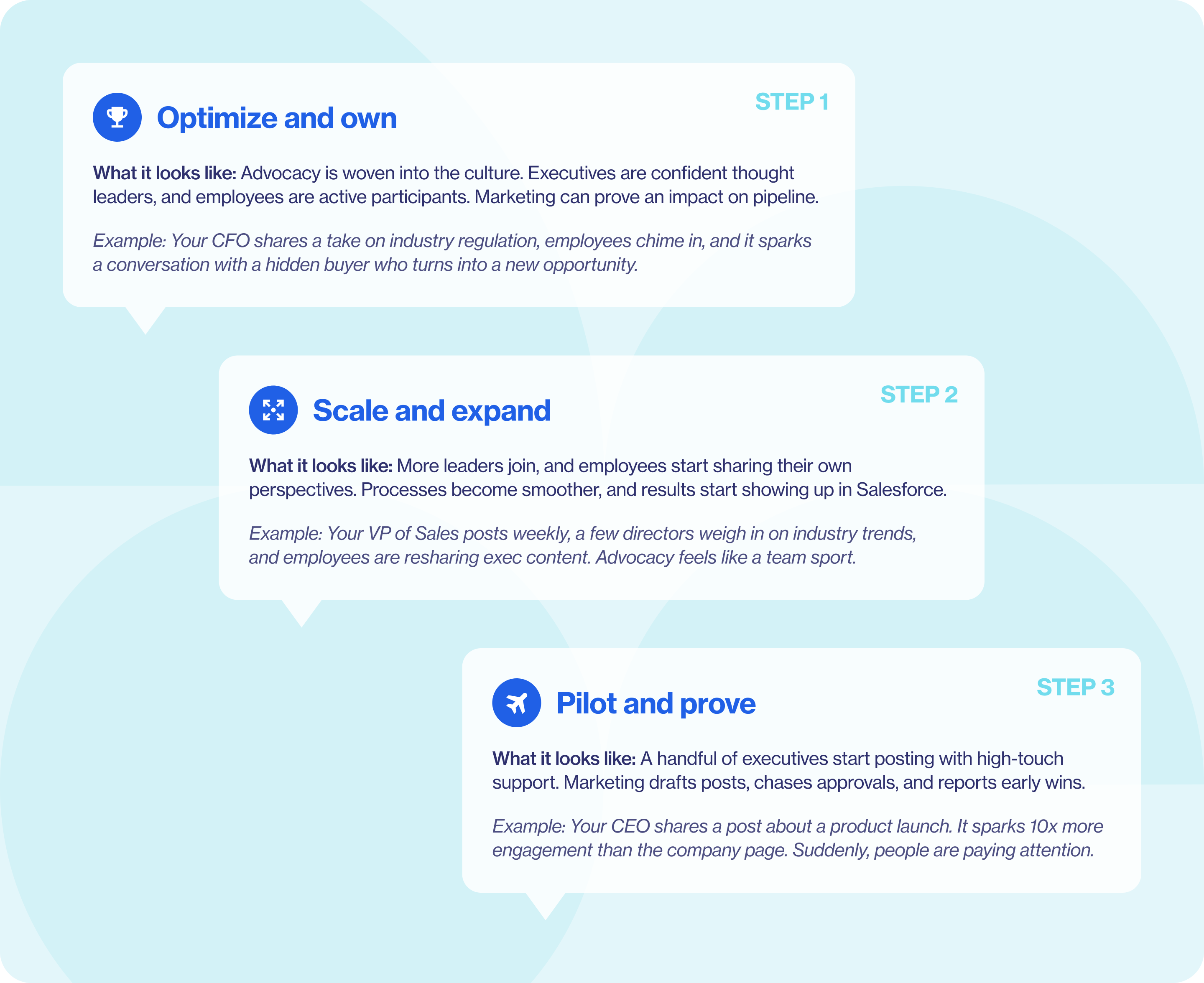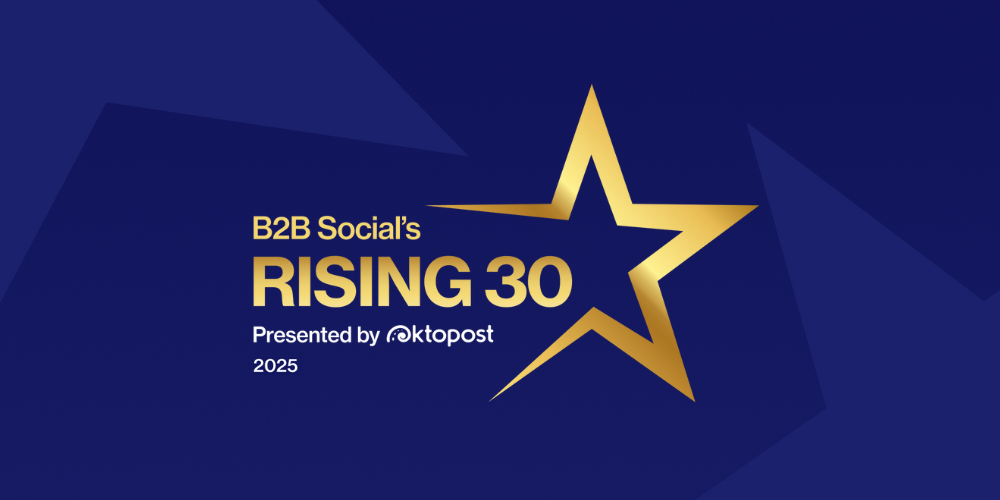How executive advocacy builds B2B pipeline at scale

Table of contents
- Why executive voices matter to B2B buyers
- Moving beyond campaigns: Build a scalable advocacy strategy
- The executive advocacy ladder: From C-suite to employee
- Can AI replace executive thought leadership?
- Measuring the ROI of executive-led advocacy
- Keeping advocacy programs alive: Strategy for the long haul
- How Oktopost powers executive-led growth on social
“So I saw this great LinkedIn post that got me thinking…”
Chances are, the last time you said this, you weren’t talking about a marketing post. The idea that got you thinking came from a leader you follow, one of those execs whose voice has become part of your daily scroll.
And if you’re in a buying role, you can likely name those executives without a second thought. That’s exactly the kind of relevance you want for yourself (if you’re a leader), and your executives (if you’re managing B2B social media).
Why executive voices matter to B2B buyers
B2B buyers aren’t waiting for your next guide or whitepaper. They’re scrolling LinkedIn, tuning into peers, and lurking quietly in the background. These “hidden buyers” are researching without following your brand or filling out a form. They’re making decisions long before your SDR ever picks up the phone or messages them. Frequently, they aren’t announcing themselves with a follow, a like, or a form fill. But they are listening to what people in the industry are saying, especially thought leaders and executives.
That’s why executive advocacy has become one of the most powerful drivers of employee advocacy, and by extension, pipeline. When leaders are visible, authentic, and consistent on social media platforms, employees follow their example. Together, they create reach and trust that brand channels alone can’t deliver.
Moving beyond campaigns: Build a scalable advocacy strategy
One of the biggest mistakes companies make is treating advocacy like a campaign. They put out a few weeks’ worth of posts, generating some launch buzz. Then silence.
For executives, especially, it has to be framed as a strategy that scales and evolves. Leaders don’t want a one-off. They want to see that their time and effort will compound.
The best way to secure buy-in is to show them a maturity curve:
- Step one: This is your pilot stage. The goal here is to prove that executive voices can drive reach and engagement. Provide high-touch support: drafting, coaching, and handholding to remove friction.
- Step two: Now it’s time for expansion. Bring more leaders on board, roll out to different departments and regions, and start showing measurable pipeline impact. Executives begin to post more independently as they see results.
- Step three: If you’ve got this far, your B2B marketing team can focus less on execution and more on optimization. By now, executives are confident thought leaders, employees are active participants, and advocacy is directly tied to revenue reporting.
Executives think in terms of scale and repeatability. Marketing teams should learn from this.
When you show advocacy not as a marketing experiment but as a strategy that can live and breathe for years, you’re speaking their language.

Recommended for further reading
The executive advocacy ladder: From C-suite to employee
Executive advocacy works best when you treat it like a ladder. Each rung builds on the one below it. Together, these levels can extend your reach and build credibility that no branded channel can match.
The top rung: executives
They’re the spark that sets everything in motion. Give your execs white-glove support. This includes curated posts, ghostwriting help, and most importantly of all: clear metrics for success.
Middle rung: senior leaders
Directors and VPs serve as the bridge between executive voices and the broader employee base. They also play a crucial role in projecting specialized or niche expertise to your brand’s audience. They might not need the same level of hand-holding, but they benefit from tailored prompts, coaching, and AI-assisted tools to scale their presence.
Bottom rung: employees
Your employees are the broad base that carries advocacy into new networks. They thrive when you provide easy access to shareable content. That can include industry insights, cultural moments, and company news that they can make their own.
Each rung matters. Executives model the behavior, leaders amplify it, and employees carry it further. Put them together, and you have an advocacy program that climbs steadily toward impact.
Can AI replace executive thought leadership?
The role of AI continues to be one of the hottest topics in B2B marketing. Of course, AI has changed the game for advocacy. It can draft captions, reframe tone, and generate variations in seconds. That makes it easier to scale support, especially when you’re helping multiple executives at once.
But there are limits. AI can’t tell your CEO what they actually think about a market trend. It can’t capture the sense of pride, urgency, or frustration that makes a post feel alive. You can verify this yourself by looking at the posts that actually get you to read them. They are most likely not emoji-laden and full of the kinds of cliches that we have all come to associate with unedited AI outputs. Without human direction, an executive feed that’s entirely outsourced for AI will start to look like a corporate recycling bin for second-hand, leftover ideas that didn’t make it onto the corporate channel.
The best programs find the balance: AI for efficiency, executives for perspective. Use AI to clear the admin work, but insist that leaders add their own opinions, reactions, and insights. Alternatively, assign a creative in your team to support them. But even here, it’s essential to make sure that no ghost writer overrides the individual voice that will make the posts worth reading.
In short, there will be some trial and error here. To figure out what’s working, as always, you’ll need to rely on data, which is where we’re going next.
Measuring the ROI of executive-led advocacy
What matters is the pipeline. With UTM tracking, CRM integrations, and LinkedIn’s profile analytics, you can see exactly how advocacy content influences leads. Present those numbers quarterly: pipeline sourced, opportunities influenced, audiences reached.
UTM tracking for demo requests
Say your CEO posts a thought leadership piece with a link to a demo page. Using UTM parameters, you can see exactly how many demo requests originated from that post: down to the campaign, source, and even the individual link.
CRM attribution
An SVP posts about an industry report. A prospect clicks, lands on your site, and later enters an opportunity. Because Oktopost pushes social activity into your CRM, you can attribute that opportunity back to the SVP’s post, not just “social” in general.
LinkedIn profile analytics
With LinkedIn’s new Profile Analytics API, you can measure how executive posts perform in terms of impressions, video completions, follower growth, and reposts. If your CRO gains 500 new followers in your target industry after a consistent posting streak, that’s a tangible leading indicator of influence.
Opportunity influence reports
Imagine your CFO comments on a regulation trend. Two weeks later, a prospect who engaged with that post shows up in your pipeline. With CRM integration, you can show: this account engaged with X executive’s post before entering the opportunity stage.
Keeping advocacy programs alive: Strategy for the long haul
Advocacy often launches with a bang. There’s lots of enthusiasm, lots of sharing, and then everything slowly fizzles out. To sustain momentum, advocacy needs to be more than a marketing initiative. It has to feel like part of the culture.
One of the most effective ways to keep it alive is to let executives do the reminding. When encouragement comes from the top (whether it’s a quick note in Slack or a mention in an all-hands meeting), employees see that advocacy is a priority. Content also needs to stay fresh. A program that recycles the same assets month after month quickly feels stale, so it’s worth planning regular refreshes, every six months at minimum.
Most importantly, listen. Ask employees for feedback on what’s working, what feels awkward, and what could be improved. Then act on it. When people see their input reflected in the program, they stop treating it as “marketing’s project” and start owning it as their own.
How Oktopost powers executive-led growth on social
At the end of the day, advocacy isn’t just about reach. It’s about revenue. When your executives lead, employees follow, and data ties it all back to the pipeline, you’ve built a social selling engine that works quietly in the background, while your competitors are still begging for clicks on their brand page.
Employee advocacy, mainly if it’s led by executives, connects people to people, scales across your organization, and turns authentic voices into measurable growth. The companies that get this right are winning trust and strengthening their pipeline.




